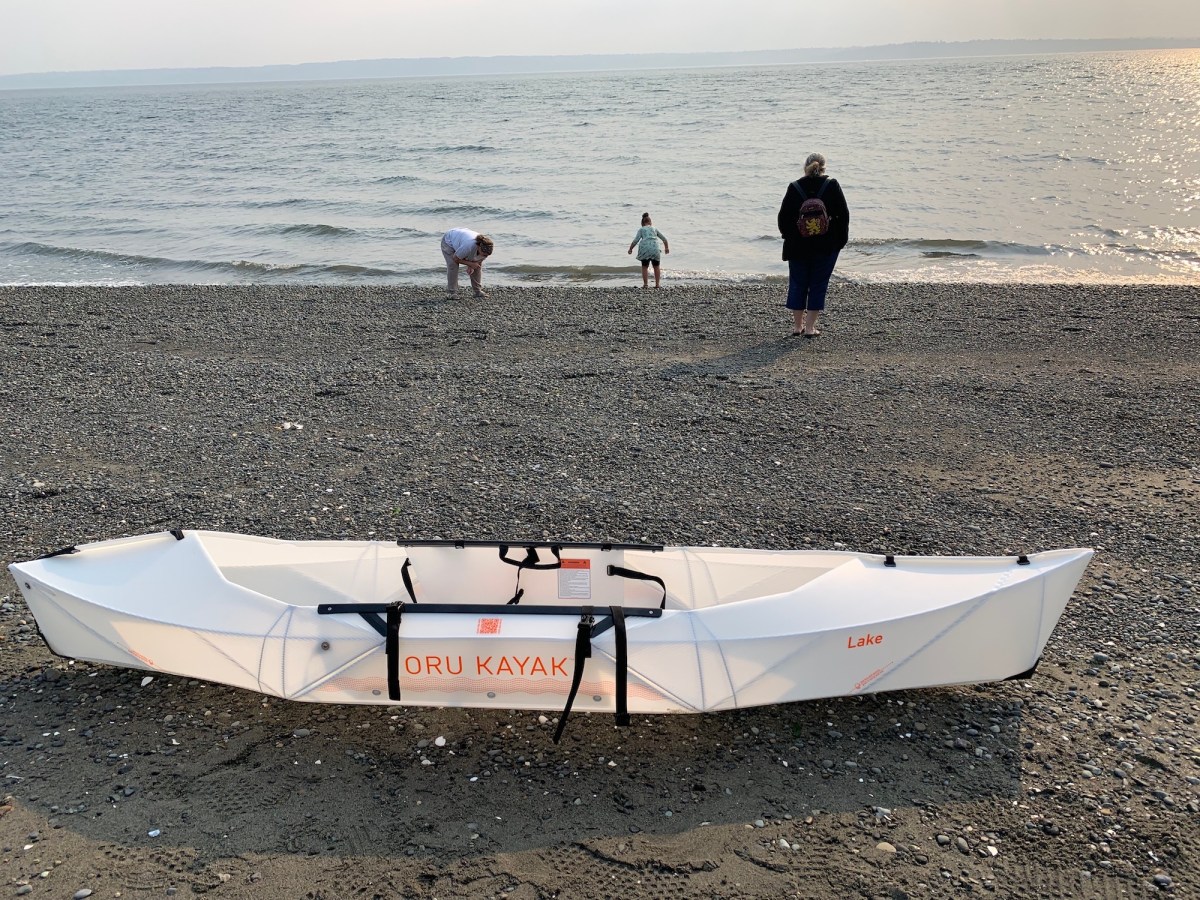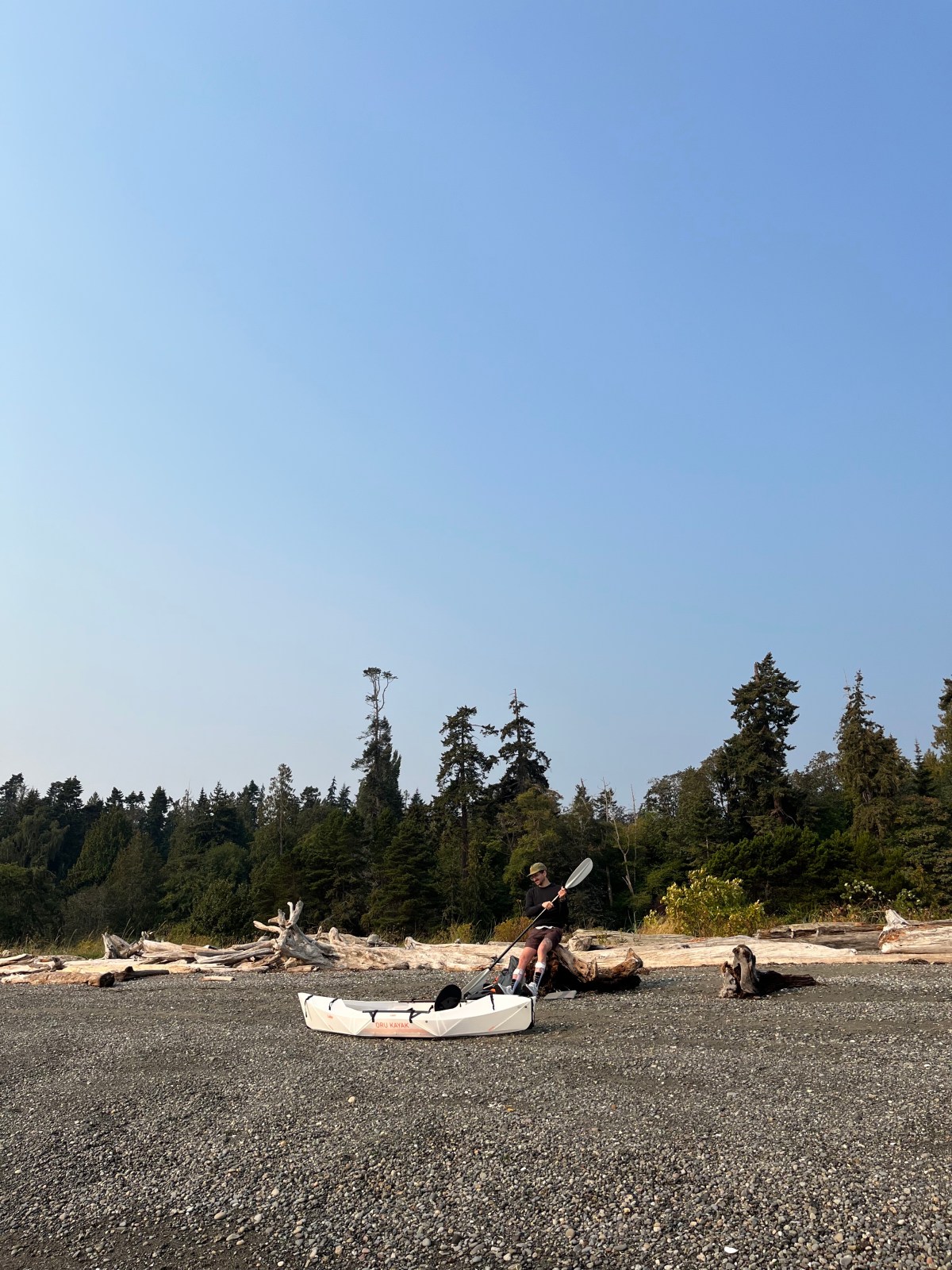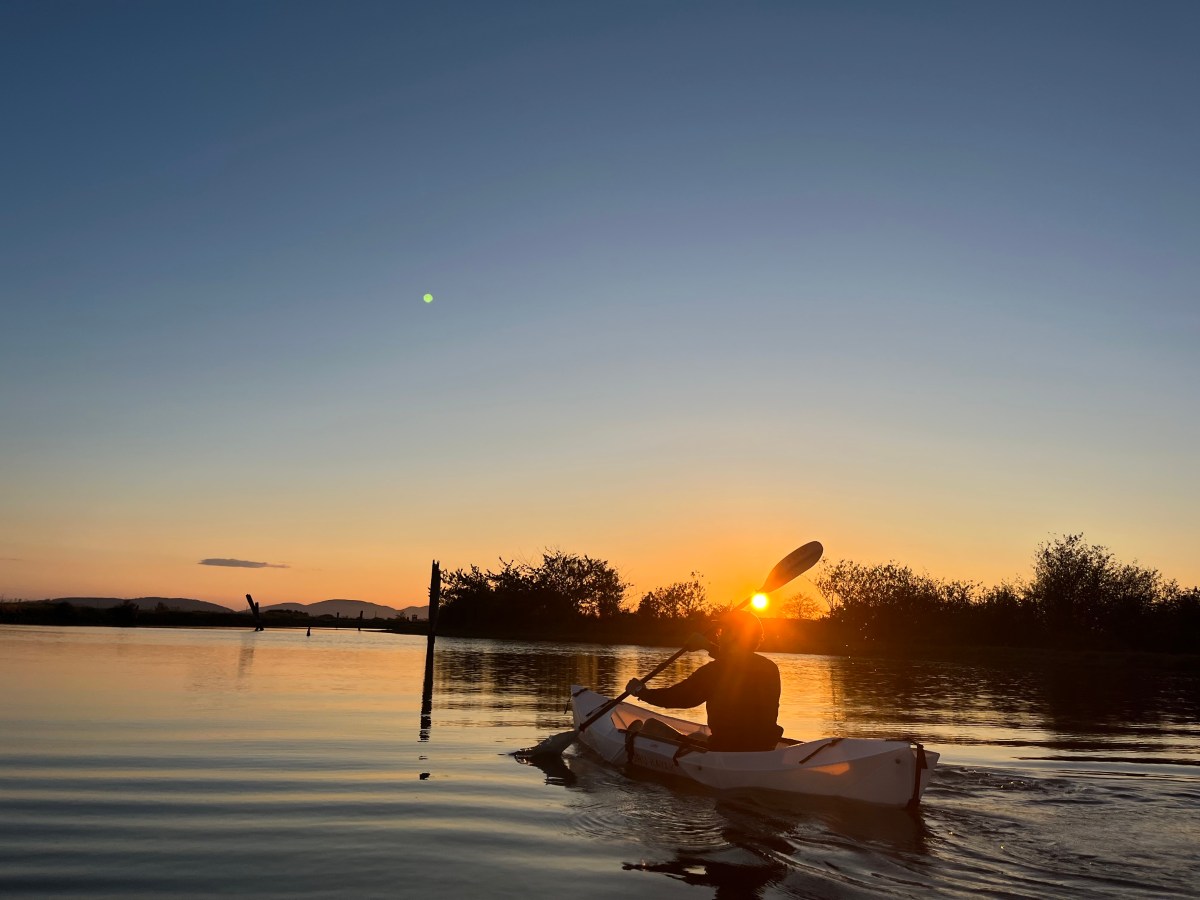I hate disturbing the water when I’m paddling. It’s such a perfect plane of glass, playfully reflecting rays of sunlight. I dip the edge of my paddle gently, trying not to stir the water more than necessary. Kayaking’s a gentle way to move. Smooth. Easy.
This way, I can get lost in nature. I quiet my mind and let myself slip into the world around me. The shrill call of a seagull breaks the gentle slap of water against my kayak. The steady rhythm of my rocking boat grounds me with my surroundings. I’d never been into watersports until recently, but this simple tranquility was what I’d been missing since disability changed my life.
I stop paddling and let the boat glide as I bend close to where the herons nest. My ultralight 9-foot Oru Kayak Lake Kayak holds a good line and I look to see if the birds are home. As I slow to a near stop, my boat and mind begin to drift.
While I love how this boat connects me with the outdoors, deep down, there’s still a part of me that would rather be rock climbing or mountain biking. While I’m newer to paddling, I’d spent the past decade roping up in the mountains or pedaling down wooded trails—I felt challenged and free to express myself in physical pursuits. These activities had become a central part of my identity—until I found myself unable to do them.

Everybody’s journey with disability is different. For example, youth and perceived “good health” in my teens and 20s delayed doctors’ ability to recognize what we now know were early warning signs of a complex neurological condition.
I started climbing in high school and would spend as much time as possible at every crag and bluff within driving distance. After graduating from college and wearing out a copy of Fred Beckey’s Challenge of the North Cascades, I moved to Seattle to get closer to the mountains I’d read about. I got a job at a local gym and found a community of climbers who welcomed me with open arms. With a plenty of climbing partners and carpools to the crag, Washington felt like one huge playground.
Despite my active lifestyle, I’d have periods of intense symptoms, from spasming muscles to bouts of vertigo. I would endure these episodes from the safety of my bedroom, waiting for them to pass like a bad dream. Hospital visits and appointments with specialists were fruitless, often caused by long wait times that allowed symptoms to abate. After a week or two in bed, I’d slowly begin riding my bike and gently begin climbing again, and gradually my complaints seemed small in the rearview mirror. After all, most days, I could do everything I wanted to do—until I couldn’t.
The one treatment I’ve always been able to rely on is my time outside.
In 2018, after years of unexplained dips in my health, I took a dive and never came back up. I took medical leave from work, finding it impossible to balance the onslaught of appointments and tests alongside daily life and my work responsibilities. I mostly stopped climbing because I worried about the safety of whoever I was roping up with. My cycling became gentler too, and I’d give my body a recovery day or two after a ride. This slowed-down season of my journey was in many ways the hardest. After forming many friendships while climbing and pedaling, stepping away from these activities felt like stepping away from my community.
My condition worsened, and I lived with the constant, difficult unknowns of an autoimmune condition. New symptoms. New tests. New clues. New pills. New specialists. Deciphering it all is overwhelming, especially when you’re already exhausted.
Eventually, I was diagnosed with a rare autoimmune disorder that leaves me with weakened motor control and muscle spasms along with a laundry list of comorbidities that so often accompany these types of conditions. The feet that used to delicately scale rock faces began to lose feeling while, at the same time, I was losing the connection to my community of climbing and cycling pals. And with so many diagnoses over the course of my medical journey, it’s been hard to know how to share this process with others, let alone find the most effective treatment when so much about my condition is still unknown. However, the one treatment I’ve always been able to rely on is my time outside.

My attention snaps back to the present moment as my Oru Lake scrapes against the inlets shallows. I notice groups of people milling around the put-in. I feel an anxious swell in my chest as I prepare to leave the safety of my kayak.
My brief respite on the water has come to an end. The thoughts spiral as I face, once again, the reality that my body doesn’t work like it used to.
Will anyone comment on my difficulties?
Is there anywhere to sit while I put my boat away?
I hope I don’t fall trying to get out.
Unlike my boat—which weighs just 17 pounds—my legs feel heavy, unstable, difficult. And it’s not just my body that’s different now, but my life too.
Getting outside isn’t the only difficulty—the whole world is hard to navigate. If you’ve ever had to use any mobility aid for any period of time, you realize the gulf between your physical limitations and the accessibility that the world offers. And sometimes the toughest barriers come from within: Internalized ableism kept me from getting outside for almost a year, unconvinced I could access the goodness outside since things wouldn’t be like they used to.
All that changed when I got my Oru folding kayak. Designed for ultimate portability and a minimal footprint, the Oru Kayak Lake Kayak is one of the lightest and most portable kayaks on the market. After launching its first model on Kickstarter in 2013 Oru has developed eight kayak models and collected loads of awards from the likes of Outdoor Retailer and Red Dot Design. In addition to being durable thanks to abrasion- and puncture-proof materials, Oru boats’ unique folding design will change your experience of the water because it mitigates the hardest part: Getting your vessel afloat.
For backcountry paddlers, hiking miles in to paddle a remote lake, a kayak light enough to carry on your back through hilly terrain is essential. But for someone with a physical disability, getting the boat from the car to the water—no matter the distance or terrain—can be the hardest part of the activity. Oru’s ultralight design solves the problem for both paddlers.
Even though my local approach from car to water is about 20 yards of flat gravel and grass, the Oru Lake’s lightness allows me to go to the water independently. Despite the kayak being marketed for “remote water and travel to foreign lands”, it creates access for me in my local spots—especially since living on an island in Washington provides plenty of available launching places. When I’m feeling up to it, I love to paddle out to the more placid area of the Puget Sound, past where the waves break. I’ll stop and watch the water for a while, enjoying being small and surrounded by something large.
Sometimes the toughest barriers come from within: Internalized ableism kept me from getting outside for almost a year, unconvinced I could access the goodness outside since things wouldn’t be like they used to.
The folks at Oru Kayak believe that this connection—between the big and small, humanity and nature—is a deep need.
“The idea was to look to overcome the barriers to entry of storing a boat and getting it to the water. Even if you live in a city, like me,” says Oru director of product Forrest Harvey, who paddles often near his home in Oakland, California.
Not only does the Oru Lake pack down small enough to haul on a hike, but it can also easily fit into a car trunk, saving your back from loading and unloading a roof rack. It could easily be stored in an apartment, basement or storage unit.
It’s also simple to set up and pack down. I wouldn’t call it easy, per se—especially if you have any physical disability—but folding and unfolding it requires less time and effort than inflatable kayaks typically do. I’ll admit I found it tricky to pack down an Oru kayak when it was new, but over time the folds crease more naturally.
Harvey and the Oru Kayak design team works with a diverse group of kayakers whose mix of physical abilities and experience helps the brand gain insights into the user experience. Any time the Oru team changes a feature, it ensures current boats can be updated with the improvements.
For someone who only had limited paddling experience, I was curious about how the boat would handle. The Lake Kayak is the smallest of Oru’s offerings—I thought, surely, something this lightweight would feel a bit squirelly on the water compared to the heavy plastic kayaks I had used in the past. However, I find the boat to be really easy to handle and stable. In addition to always wearing a personal floation device, I opted to also add float bags in case I were to ever capsize or take on water.

As I pull up to the shore, my mind still holds onto my doubts and fear of judgement. I try to push them aside, remembering that they’re reflections of my insecurities rather than of my reality. There are more important things to pay attention to—like the heron swooping down from their nest or the cold lake water’s smell as the tide begins to change. I feel a bit more grounded, equally tired and energized from my time outside.
My appetite for my “old life” is still strong. I’ll sit with the emotions, mourning the bicycles collecting dust avoiding the closet containing storage bins full of climbing gear. But when I dig deeper, I realize it’s not bouldering I miss—it’s the feeling of ragged creativity on the rock. It’s not that I miss long-distance cycling, rather I miss perseverance and rhythm through winding roads and quiet pines. Now, I look to re-create these experiences in new ways.
Kayaking has offered a new rhythm and a literal vehicle for reinvention. While it differs from my old pursuits in many ways, it retains the important bits: the peace of mind that comes from the stillness and the sense of self-reliance that only the outdoors can well up.
Thankful for my time on the water, I reach the shore, and carefully pull myself up and out of the kayak, using my paddle for support. I take some time to lounge in the sun and allow the boat to dry in the afternoon heat. After a few minutes, I pack up, wondering when I’ll be able to get back out on the water again. Despite having a kayak that creates so much access, my disability forces me to closely monitor my symptoms and pace my exertion, like many others in the disabled community.
According to the U.S. Census Bureau, around 13% of the United States population are disabled. That means there’s probably someone you know who deals with a disability. We’re cyclists, we’re runners, we’re kayakers and climbers—we’re members of REI Co-op. Our disabilities could be visible or invisible. They could fluctuate or be consistent. They could be congenital or occur later in life. Living with our disabilities could be an identity we are proud of or one we prefer to keep private. Some of us have found ways to access outside and some still encounter barriers. Even folks who don’t have diagnosed disabilities can struggle to get outside. That’s why gear accessibility is essential to outdoor equity, not just a nice-to-have—it means making the outdoors truly available for all.
The water, in many ways, has become a refuge. I feel a sense of a control over my boat, but also a comforting smallness in comparison to the vast body of water. I wish I could bottle the feeling, fill up a truckload and start selling it at the co-op. Lucky for us, Oru managed to fit it into a backpack.
